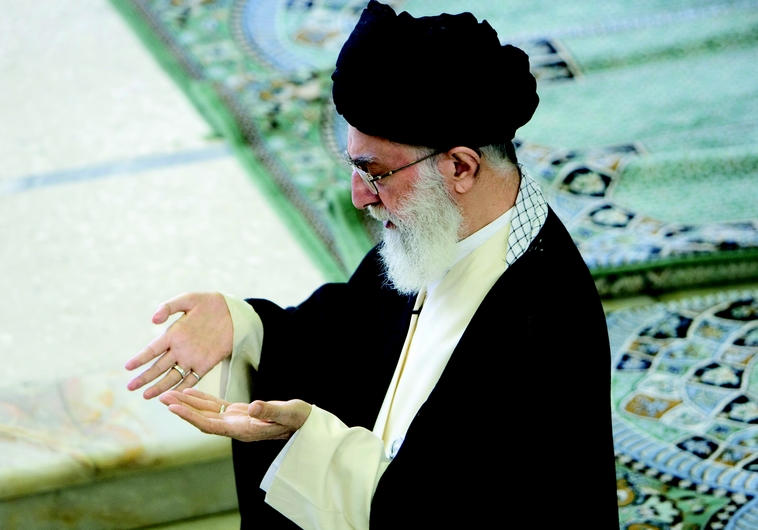A Strange Budget for a Strange System
Amir Taheri /Asharq Al Awsat
Friday, 12 Dec, 2014
What do you do when your ambitions are bigger than the resources you have to pursue them? The Tehran leadership must have asked itself this question when drafting the national budget for the next year (according to the Iranian calendar), which starts on March 21.
Since his election, President Hassan Rouhani has missed no opportunity to paint a black tableau of an economy, which he says—shaking his head in feigned sorrow—he inherited from “that man,” former President Mahmoud Ahmadinejad. Rouhani has promised to “repair the damage” done by Ahmadinejad and restore the health of the economy.
However, his new budget, because he is either unable or unwilling to contemplate serious reforms, amounts to a bill of goods rather than serious economic policy.
When presenting the draft budget, Rouhani made three claims. The first was that the budget was based on oil prices of around 75 US dollars per barrel. While oil represents around 11 percent of the Iranian gross domestic product (GDP), it accounts for almost 30 percent of the 312 billion US dollar budget. The trouble is that no one knows where oil prices might go over the next year. The problem is further complicated by the freezing of over a billion dollars of Iranian oil revenue every month by the so-called P5+1 group (the US, UK, France, Russia, China, and Germany).
Rouhani’s second boast was that he is offering a balanced budget. He must have got that obsession from his band of “Chicago Boys,” US-trained economists who regard the need to balance the budget as an article of faith. They don’t realize that when an economy is in decline, as is the case with Iran’s right now, cutting public expenditure, which means reducing demand, could worsen the situation.
According to the Institute of International Finance, the Iranian economy has shrunk by 8.6 percent since 2012. This has led to a jump in unemployment from 11 to 16 percent, which, in turn, has provoked a sharp fall in consumer expenditure. In such a situation the sanest policy would be to aim to raise investment in sectors, most notably infrastructure, that could boost the job market. Obsessed by his “balanced budget” boast, Rouhani has done the opposite by reducing or cutting funding for over 4,000 projects of all sizes.
The president has also increased the military budget by 33 percent. The lion’s share goes to the Islamic Revolutionary Guard Corps (IRGC), which sees its budget rise by 50 percent to 6.7 billion dollars. If we take into account the part of the public sector controlled by the IRGC, often through Khatam Al-Anbia Holdings, it appears we are witnessing a dramatic militarization of the economy.
Then we have the separate, and secret, budget allocated to the IRGC’s Al-Quds Force, whose mission is to export revolution through Hezbollah and a network of other Khomeinist outfits in seventeen countries. Deeply involved in Lebanon and Syria, which costs the Treasury an estimated 2.8 billion dollars a year according to conservative estimates, Iran is being dragged into the Iraqi quagmire in the hope of seizing control of a corridor spanning from the Iranian-Iraqi border to Syria and Lebanon.
To balance his budget, Rouhani has done something else. Not only has he all but ended transfers to the Oil Revenues Reserves Fund set up by Ahmadinejad for a rainy day, but now envisages treating it as a cookie jar to be raided. Yet another trick Rouhani has used is to slash many subsidies that help the poorest Iranians survive. One immediate effect of this is a 30 percent rise in the price of bread, the staple food of 90 percent of Iranians.
Even then the figures simply don’t add up. By our calculation the proposed budget has a 7.8 percent built in deficit.
The draft is based on the hope that the inescapable deficit would be covered by an increase in indirect taxes, customs duties and a new generation of treasury bonds. Rouhani is not the first to use that stratagem. All Khomeinist presidents have practiced what could be called economic taqiyah (dissimulation) to produce balanced budgets. Rouhani is also counting on further falls in the value of the currency, the rial. Iran finds itself in a peculiar situation in which the government has a vested interest in the decline of its currency, which would allow the government to get more rials for its dollars. Thus, Rouhani’s promise of increasing public sector pay by an average of 14 percent could easily be covered with a 20 percent fall in the value of the rial. With inflation estimated at around 20 percent, public sector workers will end up at least six percent poorer.
In the best circumstances the Iranian state’s ability to collect taxes of all kinds is equal to 25 per cent of GDP. However, no government, under the Shah or under the mullahs, has ever come close to that amount. And yet the Iranian economic model is a top-heavy statist one. I remember a visit in 1978 by Margaret Thatcher, then leader of the British Conservative party but not yet prime minister, during which she mocked Iranian leaders for having created an economy that was “more Socialist than that of Poland,” then under Communist rule. Though not entirely accurate, the jibe contained a grain of truth.
However, the difference between then and now is that under the Shah the state did indeed dominate, and to some degree controlled, the economy. Under the mullahs the state has become one player among many. Para-state players, notably the IRGC, revolutionary foundations, the network of businesses reporting to the “Supreme Guide,” and business empires controlled by mullahs, are regarded as part of the public sector and pay no taxes to the state. They constitute a parallel “grey economy” worth at least 100 billion dollars a year.
Even in the private sector, many entrepreneurs have learned to circumvent the state by setting up businesses alleged to have a religious mission. Instead of paying taxes to the state, they claim to be paying the “share of the Imam” (sahm e emam) to mullahs, and refuse to publish their accounts.
Call it “Islamic Socialism” if you like, but the system in which Rouhani presents his budget is a strange beast in which religion is in the service of business. Some in the West claim that Islam needs a separation of religion and politics. However, in the case of Iran at least what is more urgently needed is a separation of religion and business.
إيران: ميزانية لنظام اقتصادي غريب
أمير طاهري/الشرق الأوسط/12.12.14
ماذا تفعل عندما تكون طموحاتك أكبر من الموارد اللازمة لمواصلة هذه الطموحات؟
من المؤكد أن القيادة في طهران طرحت هذا السؤال عند وضع الميزانية الوطنية للعام الإيراني المقبل، الذي يبدأ في يوم 21 مارس (آذار).
لم يتوانَ الرئيس حسن روحاني، منذ انتخابه، عن اقتناص أي فرصة لرسم صورة سوداء عن اقتصاد يقول عنه، وهو يهز رأسه في حالة من الحزن المصطنع، إنه ورثه من «هذا الرجل»، وهو يقصد ذلك الرئيس السابق محمود أحمدي نجاد.
وعد روحاني بـ«إصلاح الضرر» الذي خلفه أحمدي نجاد، وباستعادة حيوية الاقتصاد.
ومع ذلك، فإن ميزانيته الجديدة تُعتبر، إما لأنه غير قادر على (أو لا يرغب في التفكير في) القيام بإصلاحات جدية، مشروع ميزانية من السلع أكثر منها سياسة اقتصادية جادة.
لقد قدم روحاني 3 مزاعم أثناء عرضه للميزانية.
أولها أن الميزانية تستند إلى افتراض أن سعر النفط يبلغ نحو 75 دولارا للبرميل. رغم أن النفط يمثل 11 في المائة من الناتج المحلي الإجمالي الإيراني، فإنه يشكل نحو 30 في المائة من الميزانية التي تبلغ 312 مليار دولار.
وتكمن المشكلة في أنه لا يدري أحد إلى أين ستتجه أسعار النفط خلال العام المقبل. وتزداد المشكلة تعقيدا مع استمرار تجميد ما يعرف بمجموعة «5+1» لأكثر من مليار دولار من الدخل الشهري من صادرات النفط الإيراني.
الادعاء الثاني لروحاني هو تباهيه بأنه يقدم ميزانية متوازنة.
لا بد أن هذا الهوس الذي أصابه بشأن الميزانيات المتوازنة أتاه من مجموعة الاقتصاديين الذين دربتهم الولايات المتحدة تحت اسم «شيكاغو بويز»، وكانوا ينظرون إلى هذا المفهوم باعتباره عقيدة دينية. فهم لا يدركون أنه عندما يكون الاقتصاد في حالة تراجع، كما هو الحال مع إيران في الوقت الحالي، فإن خفض الإنفاق العام، الذي يعني خفض الطلب، قد يزيد الأوضاع سوءا.
وفقا لمعهد التمويل الدولي، انكمش الاقتصاد الإيراني منذ عام 2012 بنسبة 8.6 في المائة. وأدى هذا إلى قفزة في معدل البطالة من 11 إلى 16 في المائة، أدت بدورها إلى انخفاض حاد في الإنفاق الاستهلاكي. في مثل هذه الحالة، فإن السياسة الأكثر حكمة ينبغي أن تهدف إلى زيادة الاستثمارات في قطاعات، أبرزها البنية التحتية، يمكنها أن تعطي دفعة لسوق العمل.
ولأنه مهووس بالتباهي بموضوع «الميزانية المتوازنة»، فقد قام روحاني بالعكس، عن طريق خفض أو قطع التمويل عن أكثر من 4000 مشروع من جميع الأحجام.
وبدلا من ذلك، قام بزيادة الميزانية العسكرية بنسبة 33 في المائة. وذهب نصيب الأسد للحرس الثوري الإيراني، الذي ارتفعت ميزانيته بنسبة 50 في المائة لتصل إلى 6.7 مليار دولار.
وإذا نظرنا إلى الجزء الذي يتحكم فيه الحرس الثوري الإيراني من القطاع العام، غالبا عن طريق مجموعة «خاتم الأنبياء القابضة»، فإننا سنشهد عسكرة مدهشة للاقتصاد.
ولدينا كذلك ميزانية منفصلة وسرية مخصصة لفيلق القدس الذي تتمثل مهمته في «تصدير» الثورة، من خلال شبكة مكونة من «حزب الله» وجماعات خمينية أخرى موجودة في 17 دولة. فإيران الضالعة بشكل عميق في لبنان وسوريا، التي تكلف الخزينة نحو 2.8 مليار دولار سنويا، وفقا لتقديرات متحفظة، يتم جرها إلى المستنقع العراقي على أمل السيطرة على ممر يمتد من الحدود الإيرانية العراقية حتى سوريا ولبنان.
من أجل تحقيق التوازن في ميزانيته، قام روحاني بشيء آخر. ولم يكن هذا الشيء سوى تجفيف تحويلات الأموال إلى صندوق احتياطي عائدات النفط الذي أنشأه أحمدي نجاد من أجل أوقات الحاجة، ولكنه يُنظر إليه الآن على أنه صندوق من البسكويت ينبغي الهجوم عليه الآن.
وهناك حيلة أخرى استعان بها روحاني، وهي خفض كثير من صور الدعم التي تساعد أفقر فقراء الإيرانيين على البقاء على قيد الحياة. يتمثل أحد الآثار الفورية لهذا القرار في ارتفاع بنسبة 30 في المائة في أسعار الخبز، الذي يعد الغذاء الأساسي لنسبة 90 في المائة من الإيرانيين.
حتى ذلك الحين لا تشكل الأرقام مبلغا ببساطة. فحساباتنا تقول إن الميزانية المقترحة يوجد بها زيادة في العجز بنسبة 7.8 في المائة.
ويستند مشروع الميزانية على أمل بأن يتم تغطية العجز الذي لا مفر منه، عن طريق زيادة الضرائب غير المباشرة والرسوم الجمركية وإصدار جيل جديد من سندات الخزينة.
لن يكون روحاني أول من يستعين بهذه الحيلة. لقد مارس جميع رؤساء الدولة الخمينية ما يمكن تسميته «التقية» الاقتصادية من أجل الحصول على ميزانيات متوازنة.
كما يعول روحاني على حدوث مزيد من الانخفاض في قيمة العملة، الريال. فإيران تجد نفسها في وضع غريب ترى فيه الحكومة مصلحتها في تراجع عملتها. ويعود السبب في هذا إلى أن الحكومة تستطيع الحصول على مزيد من الريالات مقابل دولاراتها. وهكذا، يمكن بسهولة تلبية وعد روحاني بزيادة أجور القطاع العام بمعدل 14 في المائة عن طريق خفض قيمة الريال بنسبة 20 في المائة. ومع وجود تقديرات تشير إلى تضخم بنحو 20 في المائة، سيزيد معدل فقر العاملين في القطاع العام في النهاية بمعدل 6 في المائة على الأقل.
في أفضل الظروف، تساوي قدرة الدولة الإيرانية على جمع الضرائب بجميع أنواعها 25 في المائة من الناتج المحلي الإجمالي. ومع ذلك، لم تصل أي حكومة على الإطلاق، لا في عهد الشاه أو تحت حكم رجال الدين، قرب هذا المعدل. ومع ذلك، فإن النموذج الاقتصادي الإيراني يعد اشتراكيا مثقلا. أتذكر زيارة قامت بها في عام 1978 السيدة ثاتشر، التي كانت في ذلك الحين زعيمة لحزب المحافظين البريطاني، ولم تكن قد تولت رئاسة الوزراء بعد، وسخرت خلالها من القادة الإيرانيين لأنهم أنشأوا اقتصادا «أكثر اشتراكية من الاقتصاد الموجود في بولندا»، التي كانت ترزح في ذلك الحين تحت الحكم الشيوعي. ورغم أن هذه العبارة لم تكن دقيقة، فإنها أصابت شيئا من الحقيقة.
ومع ذلك، فإن الفرق بين الماضي والحاضر يتمثل في أنه في عهد الشاه كانت الدولة تهيمن بالفعل، وسيطرت إلى حد ما على الاقتصاد.
أما تحت حكم الملالي، فلقد أصبحت الدولة لاعبا واحدا بين كثير من اللاعبين. اللاعبون شبه الحكوميين، وخصوصا الحرس الثوري الإيراني والمؤسسات الثورية وشبكة الشركات التي ترفع تقارير إلى «المرشد الأعلى» والإمبراطوريات التجارية التي يسيطر عليها الملالي، لا يدفعون ضرائب للدولة، ويمكن اعتبارهم حتى الآن جزءا من القطاع العام. إنهم يشكلون «اقتصاد خفيا» موازيا تبلغ قيمته ما لا يقل عن 100 مليار دولار سنويا.
حتى في القطاع الخاص، تعلم الكثير من رجال الأعمال الالتفاف على الدولة من خلال إنشاء شركات من المفترض أنها تحمل رسالة دعوية دينية. وبدلا من دفع الضرائب للدولة، فإنهم يزعمون أنهم يدفعون «سهم الإمام» إلى الملالي، ويرفضون نشر حساباتهم.
لك أن تسميها «اشتراكية إسلامية»، إذا كنت ترغب في ذلك، ولكن النظام الذي يطرح روحاني على أساسه ميزانيته ما هو إلا وحش غريب يكون فيه الدين في خدمة الأعمال.
يزعم البعض في الغرب أن الإسلام في حاجة للفصل بين الدين والسياسة. ومع ذلك، في الحالة الإيرانية على الأقل، الأكثر إلحاحا هو الفصل بين الدين والأعمال.






















